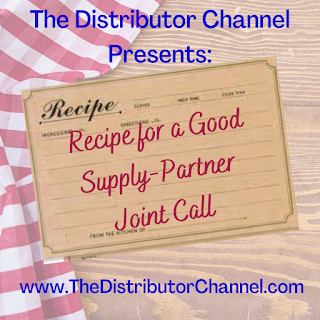Recipe for a Good Supply-Partner Joint Call
While I won’t go into precisely what sellers were peddling back in 10,000 BC, I can attest to the fact that joint calls were made in my father’s business in the late ‘50s. One of my first real career tasks came in the form of joint calls with distributor salespeople.
While the concept has remained the same, the cost has
not. Experts tell us the “typical
industrial sales call” costs close to $450.
We can theorize a joint call probably costs double that amount – close
to a cool grand. The money is getting
too big to leave anything to chance. It
is imperative to stack the deck in our favor.
Quoting a cooking expert (by accident and for the first time
in my writing):
“An important concept stressed in practically every cooking class is that cooking is 10% art and 90% chemistry. Recipes are to cooks as formulas are to
chemists - important instructions for a consistent result. In the same way that a chemist is only one missing ingredient away from disaster, the difference between a birthday cake and a pancake can be a pinch of baking powder.”Here is a recipe for
making those sales calls:
1.
Go with a purpose
Potential purposes include:
a.
Introduce
new products.
Always ask why the product is good for
the customer rather than just showing off the catalog.
b.
Better
understand an application.
Which sensor works best for this application?
c.
Solving
a potential problem.
Why are products not performing
properly or failing?
d.
Value
engineering.
Is there some new sensor that could do
the same job for less money?
e.
Thanking
customers for their business. Conversation equals
“you bought 15 sensors and we just wanted to thank you and make sure you were
100 percent satisfied with the deal.
f.
Provide
product training. Maintenance team needs to be able to
troubleshoot the sensors.
2.
Orchestrate the call
a.
Who
will you be meeting?
i. What
is their position in the company?
ii. How
do they influence the buying decision?
iii. Do
they have any links to competitors?
b.
Who
will say what?
i. Introductions?
ii. Technical
presentation?
iii. Questions
that need to be answered?
c.
What
are the potential pitfalls of the call?
d.
Who
is responsible for setting any prices if the question arises?
e.
Who
will take notes of customer comments?
f.
Who
will restate follow-ups to the customer? (examples – “Based on our
conversation, we will send you a sample” or “I will call you in the next
week and pick times for product training.”)
3.
After the call follow-up
a.
What
further actions need to be taken?
i. Questions
to explore with the customer?
ii. Is
special pricing an issue?
iii. Schedule
for another follow-up joint call? (What would be the purpose? Do
both of you need to go?)
b.
Follow-ups
i. Who
is responsible for sending literature, checking on delivery, and taking care of
other commitments? What is the proper timeline?
ii. Note:
The distributor salesperson should take on the vast majority of these.
Why? Account Control.
c.
What
could have been done better by either the manufacturer or the distributor
salesperson?
d.
Questions
about the sales, technical, or other comments made by either person. This
is a learning opportunity for both sellers.
4.
For the distributor guy
a.
Joint
calls serve several purposes with supply-partner salespeople.
i. Block
off customers from competitors with shared product lines
ii. Provide
an opportunity for learning
1.
Technical
points
2.
How
to present products
3.
What
are the deep commitments the manufacturer can make?
iii. Create
allies within our industry
1.
These
guys often come across business opportunities, not just for their products, but
for other products you sell. Being their business ally puts you at the
front of the line for these favors.
2.
It
is a give and take relationship. You will get more if you give
more. This means you should ask the supply-partner seller what you can do
for them to make their jobs easier. Don’t be surprised if the need
for ongoing information is part of the ask. Manufacturer sellers do a lot
more reporting on the status of opportunities than distributors. Often,
these guys are judged on the quality and quantity of territory data
reported. You can help them.
5.
Never, ever do any of the following:
a.
Criticize your company direction – sometimes
manufacturer guys will probe for information about what’s going on in your company.
Sometimes it is honest curiosity, other times it’s tied to other issues.
Avoid the conversations.
b.
Criticize other members of your team (including
your manager) – providing help with the right person to talk to is great.
Helping with introductions in your company is good too. Criticizing is
bad. For instance, “Jack is a good guy but he doesn’t make enough calls
on his customers” could cause damage in the future.
c.
Share information about other product
lines. This information is not part of the equation. There is
always jealousy between suppliers. They may conclude your company isn’t
focused on their products because you are engaged in a big product rollout for
someone else.
Follow this recipe – I dare you. Remember our quote above from Michael Pollick,
“The difference between a cake and pancake is a single ingredient.”
Frank Hurtte, Founding Partner of River Heights
Consulting, shares his personal experiences with 28
years of "in the trenches" training and 17 years as a
consultant. He serves as a personal coach to industry leaders across many
lines of distribution. He has authored 5.5 books (one is almost done) and
has written hundreds of articles for national trade magazines, including
Industrial Supply Magazine.
Frank is also a sought-after copywriter of marketing
materials for technology companies. His charismatic, yet laid-back,
easy-to-follow manner makes him a favorite among public speakers.
JMS






Comments